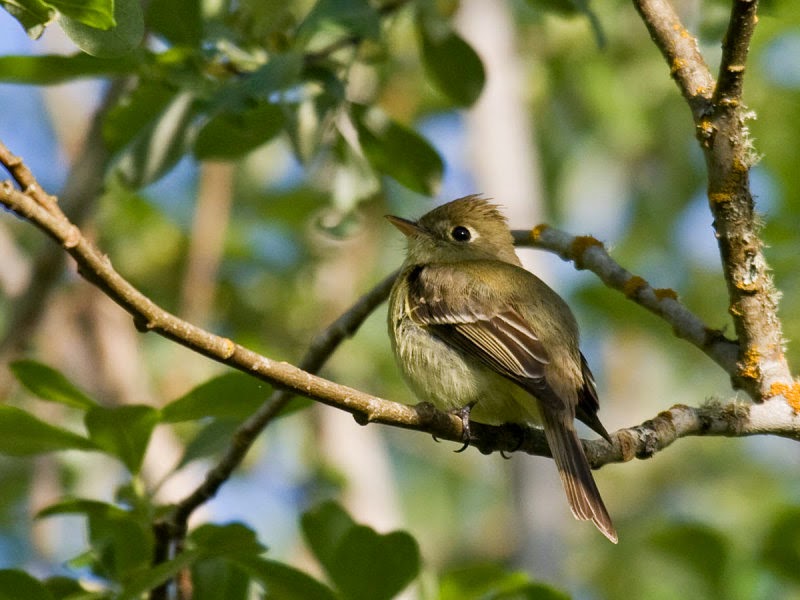Recently, I received an email from a birder asking for bird identification help. In November on the Oregon coast, he'd photographed what he believed to be a Pacific-slope Flycatcher, but wanted confirmation. He'd included two very clear photos of a greenish grayish yellow (or yellowish greenish gray) bird with two light wing bars, a pointy beak, and a whitish teardrop eye ring. Certainly could be a flycatcher!
Here is a photo of a Pacific-slope Flycatcher (this is not the photo he sent):
The field marks are all there...greenish grayish yellow (or yellowish greenish gray!), pointy beak, one of two wing bars visible, whitish teardop eye ring.
Now here are the photos he sent:
It was not a flycatcher he had photographed! It was a Ruby-crowned Kinglet, a maddeningly similar bird in looks, but vastly different in seasonality and behavior.
First of all, by November most of our flycatchers have left North America in favor of Central and South American forests. The kinglet, however, is a year-round resident and is commonly found at low elevations in fall and winter.
But even if a flycatcher did stick around past its usual departure date, it wouldn't behave like the perpetually bouncy kinglet. The stoic flycatcher sits still as it waits for a flying insect to come near, then darts off its perch to catch the bug, returning to the same or a nearby perch. The frenetic kinglet, on the other hand, gleans tiny insects and insect eggs from bark, the base of leaves, or in between needles, often hovering for a moment as it hunts. Frequently flicking its wings, it works the foliage of one bush then moves on to the next. No sitting still for this guy!
And though their plumage at first looks similar, the birds are different sizes (a wee kinglet is a mere 4 inches long!), and the kinglet's beak is tweezer-like compared to the flycatcher's more flattened beak (think about hunting style--would you try to catch a flying insect with tweezers or tongs?). In addition, the flycatcher's head has a slight peak to it, and the male kinglet sports its namesake: a secret ruby-red patch on its crown that it can reveal at will.
The next time you're faced with a little green bird, remember to think about not only what it looks like, but what it's doing and what time of year it is. Behavior and seasonality are often the key to identification of similar species, though of course the birds don't always stick to those "rules."
Soon enough these two will switch places and we'll be tearing our hair out over the oh-so-similar species of flycatcher hunting in our summer lowlands, while the kinglets will be nesting high up in the Cascades. Enjoy our winter birds!




4 comments:
Stupid flycatchers.
We always have wintering kinglets in our Berkeley garden. Recently one was low, right outside the dining room window in the sun, and the elusive ruby crown was dazzling!
Thanks for such clear descriptions.
What a terrific blog—very well written! I wish I could join you on a birding trip, but I live in WI.
Thanks for stopping by! I love writing it but don't get inspired often enough.
Post a Comment